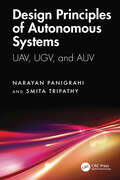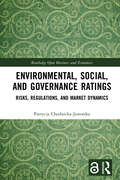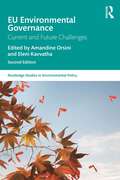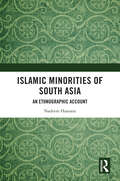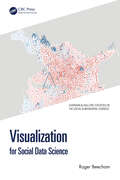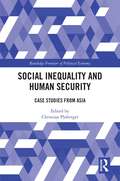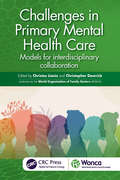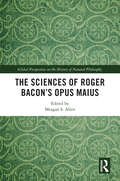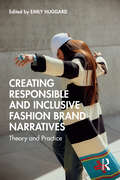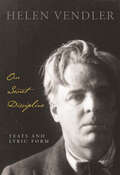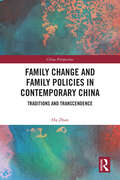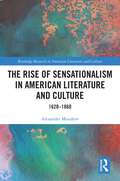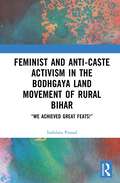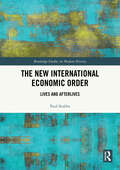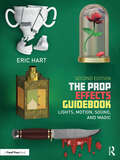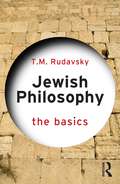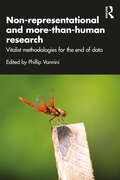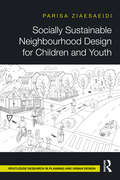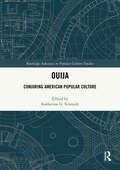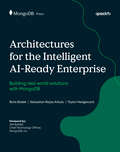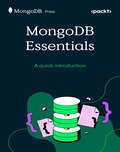- Table View
- List View
Design Principles of Autonomous Systems: UAV, UGV, and AUV
by Narayan Panigrahi Smita TripathyThis book explains unmanned systems including Unmanned Aerial Vehicles (UAVs), Autonomous Underwater Vehicles (AUVs) and Unmanned Ground Vehicles (UGVs). It also details system and subsystem compositions and their basic design. The components/subcomponents, employed payloads and sensors, and communication systems used to compose the autonomous system are discussed. It examines generic applications of these unmanned systems including specific missions for which they are employed. Other topics like swarm of drone, anti-drone system, and some algorithms used in navigation and communication of the drone are also discussed.Some key features: Helps readers understand nuances of autonomous systems on land, in air, and in sea. Explains pertinent design principles, sensors, and communication system. Lays the foundation for crafting, designing, and deploying autonomous systems for different applications. Reviews algorithms, computing, control and technology stacks required for design of UAS. Discusses software and navigation aspects of autonomous systems with the concepts of SLAM. This book is aimed at graduate students and researchers in mechatronics engineering, systems and sensors, systems and control, and aerospace engineering.
Environmental, Social, and Governance Ratings: Risks, Regulations, and Market Dynamics (Routledge Open Business and Economics)
by Patrycja Chodnicka-JaworskaIn recent years, the world of finance and investments has changed, considering measures related to environmental, social, and governance (ESG) factors for socially responsible investments. ESG scoring and ratings are used to estimate ESG risk.This book presents ESG ratings and scorings and their providers and lists problems with data quality, data sources, and unknown methodology, contributing to the green- and social-washing ESG rating phenomenon. The value of assets invested in green instruments relies on high-quality ESG ratings to measure green transition. Data greenwashing negatively impacts the financial market, especially the stock price, fund activities, and bond markets. The size of the rated company, geographical location, and industry biases are considered in understanding the greenwashing phenomenon. This book illustrates all the problems related to ESG rating inflation, conflicts of interest, models of payment, and internal and external ratings. It describes current regulations, initiatives, and practical knowledge of ESG scoring.Academics and students of financial law, economics, and financial sustainability will find this book invaluable. The practical implications in the book will benefit sustainability-concerned regulators and practitioners who estimate ESG risk (especially in financial institutions).The Open Access version of this book, available at www.taylorfrancis.com, has been made available under a Creative Commons Attribution-Non Commercial-No Derivatives (CC-BY-NC-ND) 4.0 International license.
EU Environmental Governance: Current and Future Challenges (Routledge Studies in Environmental Policy)
by Amandine Orsini Eleni KavvathaThis book presents an overview of the field of environmental law and policies within the European Union (EU) and externally, from theoretical foundations to major issues and applied governance solutions.Drawing on expertise from renowned academics and practitioners from different disciplines, EU Environmental Governance: Current and Future Challenges helps readers to understand the main legal, political and economic issues of environmental protection since the adoption of the European Green Deal in 2019. This new edition presents both current insights and future challenges as they seem to be emerging in the new geopolitical era in the EU after major events such as the COVID‑19 pandemic and the Russian invasion in Ukraine. The authors examine a broad range of sensitive and topical environmental challenges including climate change, air and environmental pollution, waste management, biodiversity protection, environmental and human health, marine biodiversity, renewable energy, nuclear energy and sustainable Arctic governance. Overall, this volume exposes the reader to a vast array of empirical case studies, which will bolster their training and help tackle the environmental challenges faced by Europe today.This book is a valuable resource for students, researchers and policymakers across a broad range of fields, including environmental law and policies, environmental economics, climate science and environmental sociology.
Ashwagandha: Potential Drug Candidate from Ancient Ayurvedic Remedy
by Dilip Ghosh and Benny AntonyFor over 3,000 years, ashwagandha has held a prominent place in Ayurveda and Unani, two of India’s ancient medicinal traditions. This revered herb, with its roots, leaves, and fruits, has been celebrated for its potent medicinal properties and adaptogenic benefits.This book is a comprehensive exploration of ashwagandha’s remarkable therapeutic potential. Drawing from centuries of traditional use and scientific advancements, it delves into the ethnopharmacology, botanical characteristics, phytochemicals, pharmacological activities, clinical trials, safety, toxicity, and formulations of this powerful herb. With growing recognition of ashwagandha as a candidate for drug development, this book critically examines its applications across diverse health domains, from neurological and reproductive health to cancer and arthritis management. It identifies research gaps that must be addressed to elevate ashwagandha to a fully commercialized, evidence-based medical intervention.Ashwagandha: Potential Drug Candidate from Ancient Ayurvedic Remedy provides insights for scientists, healthcare professionals, nutraceutical developers, and regulatory bodies. Whether seeking to develop innovative products, optimize fitness regimens, or craft informed nutritional plans, this book is the ultimate guide to harnessing the full potential of ashwagandha.
Love Letters to bell hooks: Narratives Celebrating the Influence of a Transgressive Educator
by Tricia M. Kress Robert Lake Nadia Khan-Roopnarinebell hooks was one of the most influential voices in critical and culturally-responsive education. In recognition of the magnificence of bell’s contributions to the field of education, this book is the first of its kind to bring together scholars, educators, and young people to honor her broad and deep legacy. Written in letter form, each chapter reflects how bell hooks’ many influential books have shaped the lives and livelihoods of the people who have read them. Narrative in style and accessible to a wide audience of readers, this collection serves as a bridge between the philosophical and the practical components of bell’s work, as authors demonstrate the direct influence and application of hooks’ legacy in their lives. Love Letters to bell hooks is a wonderful companion to any of bell’s other works and is especially relevant to undergraduate and graduate Education students, as well as in-service educators pursuing professional development.
Islamic Minorities of South Asia: An Ethnographic Account
by Nadeem HasnainIslam and Islamicate South Asia have generated interest since 9/11 as never before. However, Islamic Minorities, specifically, is still a relatively neglected area of study in South Asian Islam. It may be due to the reason that there has been a tendency to look at Islam as a monolithic faith and Muslims as a monolithic population to the western world.This book focuses on such Islamic Minorities as the Shias (dominant Isna Ashari/Twelver Shias), Ismaili Khoja, Dawoodi Bohra, and Ahmedia/Qadiyani communities and looks at them from the perspective of their interaction with Hindu cultures and traditions. Written in lucid language from a sociological perspective, it should be an important contribution to the field of “Lived Islam” or “Islam in Practice.”This book will be invaluable to all those interested in the religion, society, and culture of Muslim South Asia.
Visualization for Social Data Science (Chapman & Hall/CRC Statistics in the Social and Behavioral Sciences)
by Roger Beecham"This is an important book on an important topic. I particularly like the examples showing different visualizations of the same data and the parallel presentation of graphics and code. And I absolutely love the chapter on visual storytelling. I can't wait to use this book in my classes."- Andrew Gelman, Department of Statistics and Department of Political Science, Columbia University, New York"A book that gives learners the inspiration, knowledge and worked examples to create cutting edge visualisations of their own."- James Chesire, Professor of Geographic Information and Cartography, University College LondonVisualization for Social Data Science provides end-to-end skills in visual data analysis. The book demonstrates how data graphics and modern statistics can be used in tandem to process, explore, model and communicate data-driven social science. It is packed with detailed data analysis examples, pushing you to do visual data analysis. As well as introducing, and demonstrating with code, a wide range of data visualizations for exploring patterns in data, Visualization for Social Data Science shows how models can be integrated with graphics to emphasise important structure and de-emphasise spurious structure and the role of data graphics in scientific communication -- in building trust and integrity. Many of the book’s influences are from data journalism, as well as information visualization and cartography. Each chapter introduces statistical and graphical ideas for analysis, underpinned by real social science datasets. Those ideas are then implemented via principled, step-by-step, workflows in the programming environment R. Key features include:• Extensive real-world data sets and data analysis scenarios in Geography, Public Health, Transportation, Political Science;• Code examples fully-integrated into main text, with code that builds in complexity and sophistication;• Quarto template files for each chapter to support literate programming practices;• Functional programming examples, using tidyverse, for generating empirical statistics (bootstrap resamples, permutation tests) and working programmatically over model outputs;• Unusual but important programming tricks for generating sophisticated data graphics such as network visualizations, dot-density maps, OD maps, glyphmaps, icon arrays, hypothetical outcome plots and graphical line-ups plots. Every data graphic in the book is implemented via ggplot2.• Chapters on uncertainty visualization and data storytelling that are uniquely accompanied with detailed, worked examples.
Social Inequality and Human Security: Case Studies from Asia (Routledge Frontiers of Political Economy)
by Christian PlobergerThis book collates case studies of national and subnational efforts to alleviate inequality and implement development and security policy more effectively, collaboratively, and multidimensionally.While inequality is a fundamental developmental challenge and a global phenomenon, responsibility largely falls to the state to address it. This book seeks to provide a specific framework to analyse these efforts at the national and sub-national levels. It does so through the United Nations’ concept of Human Security, whose five core principles provide a good means of addressing inequality’s various facets. Each chapter opens by highlighting the specific aspect of human security that is being addressed. Specific issues covered in the volume include local economic development, maritime economies, fishing communities, governance, and public administration.This book will be of keen interest to scholars of development studies, inequality (especially social inequality), and area studies.
Challenges in Primary Mental Health Care: Models for Interdisciplinary Collaboration
by Christopher Dowrick Christos LionisThis insightful and timely book equips family doctors and other primary healthcare professionals with the knowledge and skills needed to address a diverse range of new and important challenges in the field of primary mental health care, including ongoing impacts from the COVID pandemic, thanatophobia, and end-of life care, humanitarian and geopolitical catastrophes, and the effects of climate change.There is an emphasis throughout on the need to encourage and so reap the benefits of interdisciplinary collaboration between family doctors and mental health specialists, and across the range of primary care and community workers. Effective primary healthcare relies increasingly on the use of remote consultations, and the book explains how the potential of remote working can be maximized in low-resource settings. The book concludes with a consideration of how to protect and enhance the mental health of primary care workers in the face of these ongoing challenges in care.Key Features: Global and inclusive, providing practical guidance and direction across low-, middle-, and high-income settings, satisfying the needs of all primary care practitioners regardless of geography Focused on key and immediate challenges for primary care practitioners arising from the COVID-19 pandemic, poverty, and social inequality, migration, and climate change Addresses the vital importance of self-care by and of primary healthcare workers facing unprecedented work and emotional pressures Reflecting the expertise of the WONCA Working Party for Mental Health (WWPMH), building on the foundations laid in the 2020 WONCA volume Global Primary Mental Health Care, the editors and contributors all have expertise in primary mental health care at the frontline, with backgrounds in family medicine, psychiatry, psychology, and nursing.
The Sciences of Roger Bacon’s Opus Maius (Global Perspectives on the History of Natural Philosophy)
by Edited by Meagan S. AllenThrough an examination of the Opus maius, Roger Bacon’s great scientific work of 1267, this book offers insight into Bacon’s understanding of the role of science in society and the study and practice of science in the later Middle Ages.Written at the request of Pope Clement IV (d. 1268), the Opus maius contains English Franciscan and polymath Roger Bacon’s plans for educational and ecclesiastical reform through the study of arts and sciences, which Bacon saw as having been neglected in the curricula of the major European universities. In writing the Opus maius, Bacon wanted to demonstrate that not only were the sciences a solid foundation for learning theology, but they could also improve society and help mankind attain salvation. This volume contains nine essays on the sciences Bacon thought were most important in this scheme, including optics, mathematics, astronomy, alchemy, medicine, and experimental science. Each provides a focused examination of the individual sciences, demonstrating how Bacon understood and practised them, as well as how he envisioned they would fit together into his larger programme of scientific reform.This thought-provoking collection will be a valuable resource to historians of science, medicine, and philosophy, as well as those in medieval and premodern studies.
Creating Responsible and Inclusive Fashion Brand Narratives: Theory and Practice
by Emily HuggardThis book introduces the theories and frameworks necessary to drive meaningful social change in fashion brand communication, illustrating their applications with examples of brands that prioritize social justice, decolonization, and environmental sustainability in their practices and communication strategies.Drawing on social, consumer, and cultural theories—such as Indigenous dress theory, circularity, fat liberation, and social reproduction—this book encourages students to think critically about brand communication in ways that are relevant, impactful, and aimed at transforming discourse and ideologies, rather than focusing solely on products.Through case studies ranging from Polo Ralph Lauren’s collaboration with Indigenous weaver Naiomi Glasses to material regeneration at Veja, the authors demonstrate how these narratives can be applied in practice while raising ethical questions about transparency and authenticity in fashion brand messaging. Readers will not only gain an understanding of why more inclusive and equitable brand narratives are essential but also develop the knowledge and critical thinking skills needed to analyze, interpret, and contribute to the ongoing transformation of fashion brand storytelling.Creating Responsible and Inclusive Brand Narratives will be of interest to advanced students of Fashion Communication, Marketing and Brand Management.
Our Secret Discipline: Yeats and Lyric Form
by Helen Vendler“An intellectual feast.”—John Leonard, Harper’s MagazineA monumental study reveals the patient and meticulous labor behind the Irish Nobel laureate’s immaculate poetic craft.The fundamental difference between rhetoric and poetry, according to Yeats, is that rhetoric is the expression of one’s quarrels with others while poetry is the expression (and sometimes the resolution) of one’s quarrel with oneself. This is where Helen Vendler’s Our Secret Discipline begins. Through exquisite attention to outer and inner forms, Vendler explores the most inventive reaches of the poet’s mind. This book is a space-clearing gesture, an attempt to write about lyric forms in Yeats in unprecedented and comprehensive ways. The secret discipline of the poet is his vigilant attention to forms—whether generic, structural, or metrical. Yeats explores the potential of such forms to give shape and local habitation to volatile thoughts and feelings.Helen Vendler remains focused on questions of singular importance: Why did Yeats cast his poems into the widely differing forms they ultimately took? Can we understand Yeats’s poetry better if we pay attention to its form, both its internal architectonic and its external organization into conventional verse structures? Chapters of the book take up many Yeatsian ventures, such as the sonnet, the lyric sequence, paired poems, blank verse, and others. With elegance and precision, Vendler offers brilliant insights into the creative process and speculates on Yeats’s aims as he writes and rewrites some of the most famous poems in modern literature.
Family Change and Family Policies in Contemporary China: Traditions and Transcendence (China Perspectives)
by Hu ZhanThis book examines the dramatic transformation of Chinese families in recent decades, analyzing how economic and social policies and changes have reshaped family structures and relationships.The book explores government policy responses to emerging family- related challenges while balancing traditional values with modern realities.In seven detailed chapters, the author explores key aspects of China’s family evolution, including changing family structures, intergenerational dynamics, social services, and institutional reconfiguration. The work provides an in- depth analysis of how policies have adapted to address population aging, shifting. Special attention is given to the delicate balance between preserving traditional family values and accommodating inevitable demographic and economic changes.This title will be essential reading for scholars, policymakers, and students of Chinese studies, sociology, and social policy. It will also provide valuable insights for anyone interested in understanding contemporary Chinese society and family dynamics.
The Rise of Sensationalism in American Literature and Culture: 1620-1860 (Routledge Research in American Literature and Culture)
by Alexander MoudrovThe Rise of Sensationalism in American Literature and Culture: 1620‑1860 argues that the rise of the American tradition of sensationalism can be better understood in the transatlantic context. Early American writers were unquestionably influenced by various forms of European sensationalism. At the same time, they often felt compelled to distance themselves from their European counterparts whom they accused of promoting voyeuristic indulgence in the scandalous and demoralizing their readers. American writers typically claimed that they turned to the scandalous only to promote legitimate religious, political, and social causes. In this respect, their approach reflected the Puritan tradition of didactic sensationalism in which provocative themes (religious dissent, crime, and sex scandals) were routinely exploited in ostensibly well‑intentioned publications (sermons, crime reports, and journalism). What is remarkable about the antebellum period is that it saw a dramatic transformation of American sensationalist literature as popular writers started to incorporate elements of European sensationalism while trying to preserve the didactic conventions of their predecessors.
Lao Tzu and Confucius Meet Heisenberg: Leadership Wisdom from Quantum Science and Chinese Philosophy
by Danah ZoharThis highly original book offers a new philosophy and vision of higher purpose for leaders facing the immense challenges of the 21st century. By exploring Western quantum physics and traditional Chinese thought, leading management thinker Danah Zohar develops an emergent, new East/West vision that leads not just to global co-operation but to an exciting and revolutionary global-co-creativity.Taking complex ideas and presenting these in a highly engaging and readable way, this book offers the most recent thinking of Danah Zohar's quantum management theory. It demonstrates how the roots of this new philosophy and sense of higher purpose are both ancient and modern, drawn from traditional Chinese thought that had its beginnings thousands of years ago and from quantum physics, first discovered at the beginning of the 20th century. The new generation of quantum management is characterised by being more holistic, dynamic, and humanistic. Written in a very accessible way, Danah vividly demonstrates the advanced nature and scalability of quantum management by using real-world examples.This book provides a foundation for a new leadership vision and style, based on moral renewal, greater cross-cultural understanding, and global harmony, and is truly thought-provoking for business leaders and management researchers.
Feminist and Anti-caste Activism in the Bodhgaya Land Movement of Rural Bihar: “We Achieved Great Feats!”
by Indulata PrasadFeminist and Anti-caste Activism in the Bodhgaya Land Movement of Rural Bihar examines the long-term social, spatial, and material impacts of the Bodhgaya Land Movement (BGLM) of the 1970s and 1980s on its participants and beneficiaries. This book presents an ethnography and oral history of radical feminist and anti-caste activism based on interviews with the urban, educated Vahini activists who instigated the movement and oral narratives of the rural Bhuiyan Dalit women and men who led the protests. It also analyses the maps drawn by formerly enslaved Dalit laborers to document the social changes that resulted, as well as those that failed to materialize, from the land movement. In doing so, this book theorizes the multiple oppressions and forms of resistance with which these activists engaged to bring forth their rich experiences and analyses of social conditions in Bihar. By centering caste and gender within its examination of the social movement, this book makes multiple contributions to feminist scholarship that will be of use to social scientists and advanced undergraduate and graduate students in Gender Studies, Asian Studies and other interdisciplinary fields.
The New International Economic Order: Lives and Afterlives (Routledge Studies in Modern History)
by Paul StubbsThe New International Economic Order (NIEO) was an attempt, underpinned by the agency of the Global South, to articulate global economic and social rights consequent upon political rights gained through processes of decolonisation. The New International Economic Order: Lives and Afterlives situates the NIEO within the interregnum of the 1970s, addressing its core features, intellectual antecedents, contradictions, absences, and afterlives. Particular attention is paid to the role of the Non-Aligned Movement (NAM) alongside the G-77 and UNCTAD. The book traces the orchestrated United States' opposition to the NIEO and the growth of neoliberalism at the end of the 1970s before discussing some of the NIEO’s many afterlives. It argues that analysing, translating, and adapting the NIEO is important for any re-envisioning of emancipatory global economic, political, and social relations today.Using a mixture of documentary and archive material, The New International Economic Order will be of interest to students and researchers in diplomatic history, international relations, development studies, and sociology. It brings together a large number of themes that are not usually considered together in the existing literature, combining theory and empirics in innovative ways.
The Prop Effects Guidebook: Lights, Motion, Sound, and Magic
by Eric HartThe Prop Effects Guidebook Second Edition explores how to make props for the stage that move, light up, make sounds, or interact with their environment. Whether it's a sword that glows, a vase that breaks, or a book that bursts into flames (safely), this guide shows how to bring imagination to life.The book covers practical techniques using everyday tools and materials. It explains concepts like electricity, mechanics, and pneumatics in simple terms, making them accessible even for beginners. Nearly 300 photographs, illustrations, and charts help readers understand how to build dynamic effects. In this second edition, each chapter has been updated with new technology and detailed and advanced information, more illustrative photographs and diagrams, new information on virtual prototyping methods, LED and wireless lighting technology, app-based controllers, more examples of drops, blood delivery methods, flicker effects, sound effects, and much more. The Prop Effects Guidebook bridges creativity and engineering, showing how to solve problems and adapt designs for different situations.Groundbreaking in its comprehensive approach, this guide empowers students in Prop Building courses, artists, educators, and hobbyists to create magic on stage, making it an invaluable resource for anyone with a passion for storytelling and craftsmanship.The book is complemented by a companion website featuring videos of how to create individual prop special effects: www.propeffectsguidebook.com.
Jewish Philosophy: The Basics (The Basics)
by T.M. RudavskyThis book introduces students and interested readers to two thousand years of Jewish philosophy, from its earliest inception to the current era. Fourteen chapters cover major figures in the medieval, modern and contemporary periods, as well as important themes and topics that have been part of Jewish thought for centuries. Questions and topics covered include: What is Jewish philosophy? At what point does the introduction of secular knowledge dilute, destroy, or strengthen the basic teachings found in Jewish sources? Is it possible to harmonize the domains of science and religion? How can philosophy be married to a particular religious tradition? Containing a comprehensive list of authors, as well as suggestions for further reading at the end of each chapter, Jewish Philosophy: The Basics offers an excellent starting point for anyone seeking an engaging and accessible introduction to the rich content of Jewish philosophy.Key Features and Benefits Covers traditional topics in Jewish philosophy, with an emphasis on philosophers’ struggles to reconcile faith and reason. These topics include the existence and nature of God, prophecy, miracles and divine providence, the problem of evil, nationalism, Jewish mysticism, and the status of women Clearly explains the important contributions from historical and contemporary thinkers, like Judah Halevi, Moses Maimonides, Baruch Spinoza, Moses Mendelssohn, Martin Buber Joseph Soloveitchik and many others Emphasizes the interactions with the secular intellectual world upon Jewish philosophy, ranging from the rediscovery of Aristotle in the medieval world, to the rise of modern science, as well as the importance of modern thinkers including Descartes, Kant, Hegel, Heidegger and others. Provides an overview of contemporary issues in Jewish philosophy, including Zionism and the status of women in Judaism.
Non-representational and more-than-human research: Vitalist methodologies for the end of data
by Phillip VanniniThis book fosters new links between non-representational theories and more-than-human perspectives. Offering multidisciplinary perspectives, from geography and anthropology, to social theory and qualitative research methodologies, it reimagines the boundaries of research by arguing for a new concept of “data.”Original, bold, and creative contributions provocatively push us to reimagine what is meant by data. No longer something we can unproblematically understand as an empirical given, the notion of data is reimagined as the relational outcome of encounters, engagements, attachments, and more-than-human relations. As such, the book expands the field of non-representational scholarship, challenging the ideas of data collection, analysis, and representation.This innovative book provides a courageous contemporary theoretical and methodological intervention. It will be valuable for students, researchers, and arts practitioners across the social sciences and will serve as the beginning of new methodological dialogues for years to come.
Socially Sustainable Neighbourhood Design for Children and Youth (Routledge Research in Planning and Urban Design)
by Parisa ZiaesaeidiSocially Sustainable Neighbourhood Design for Children and Youth explores social sustainability in neighbourhood design, with a particular focus on providing practical design recommendations to improve the lives of children and youth. This book provides insights from research, as well as practical, actionable design principles and strategies to create inclusive, child-and youth-friendly environments that foster social connections and community engagement.The book strongly emphasises how vibrant, engaged communities are linked to equity and long-term social and environmental sustainability. It explores how children and youth perceive social sustainability and the behaviour settings that support it. It outlines design principles and recommendations useful for creating spaces that prioritise their wellbeing and development, both as individuals and as community members. By addressing the unique needs and perspectives of young people, the book empowers urban professionals to develop neighbourhoods that are socially sustainable, inclusive, and resilient. It also touches on important topics like decolonisation, post-colonialism in design, co-design principles, and democratic design approaches and evaluates how current urban planning practices impact the design of spaces for young people.This book is an essential resource for urban planners, designers, architects, and landscape professionals who are committed to designing neighbourhoods that foster social connection, inclusivity, and sustainable community life – especially through meaningful children and youth engagement.
Ouija: Conjuring American Popular Culture (Routledge Advances in Popular Culture Studies)
by Katherine G. SchmidtTapping into a growing interest in American culture with the occult and new spiritualism, this book is the first scholarly work devoted entirely to the unique place of Ouija in American culture.On the one hand, Ouija has at different moments in history pointed to a deep fascination and openness with the supernatural in the American psyche. On the other hand, Ouija resides squarely outside of orthodox religious belief, and, as we shall see, garners suspicion and even outright rejection from various Christian traditions especially. Thus this cardboard doorway to the supernatural continues to reflect some of the most interesting paradoxes in American life.Bringing together an international team of scholars, this book shows that what qualifies as religious remains an open question, and how Americans continue to grapple with what practices lie within and without the traditions they inherit and pass on.
Architectures for the Intelligent AI-Ready Enterprise: Building real-world solutions with MongoDB
by Boris Bialek Sebastian Rojas Arbulu Taylor HedgecockCreate AI-ready enterprise solutions with MongoDB and discover how to design intelligent architectures that transform data into innovation, efficiency, and real business valueKey FeaturesComplete guide covering GenAI to agentic AI, semantic protection to multi-agent systems25+ proven AI use cases delivering measurable impact across 6+ industries15+ real enterprise case studies from Novo Nordisk, Base 39, and morePurchase of the print or Kindle book includes a free PDF eBookBook DescriptionAI is reshaping industries, yet most organizations struggle to scale beyond pilots. Architectures for the Intelligent AI-Ready Enterprise bridges this gap with practical frameworks for building AI-ready architectures that deliver lasting business value. The book helps you explore System of Action databases and see why they're revolutionizing real-time decision-making. Through real-world applications across industries, from manufacturing and healthcare to financial services and retail, you'll discover how leading organizations transform their operations. You'll learn semantic data protection techniques that enable AI in regulated industries, as well as master advanced patterns including agentic AI and multi-agent orchestration. Written by MongoDB and industry practitioners, this book combines strategy with technical depth and proven business value. You’ll modernize by enabling AI innovation while preserving existing investments, implement trustworthy AI with governance frameworks, and build scalable solutions using a unified data platform like MongoDB that delivers measurable ROI and transformation. Whether you're architecting next-generation systems or modernizing legacy infrastructure, this book provides the patterns, case studies, and expert guidance to build enterprises that’ll thrive in an intelligent future.What you will learnDesign AI-ready data architectures that scale in productionDefine systems of action and explain why they matter for enterprisesModernize legacy systems for AI-ready, unified architecturesImplement governance, privacy, and compliance frameworks for AIExplore real-world AI implementations for over six industriesDeploy production RAG and agentic systems with MongoDBApply semantic data protection in regulated industriesBuild domain-specific AI agents and intelligent copilotsApply MCP, causal AI, and multi-agent systems for future-ready architecturesWho this book is forThis book is for IT leaders, enterprise architects, solution designers, and innovators ready to transform AI potential into production reality. Whether you're modernizing legacy systems, implementing scalable AI solutions, or translating AI concepts into measurable business outcomes, this book provides practical frameworks and industry-proven patterns. Basic familiarity with enterprise systems and data architecture is helpful, but deep AI expertise isn't required.
High Performance with MongoDB: Best practices for performance tuning, scaling, and architecture
by Alex Bevilacqua Asya Kamsky Ger HartnettPractical strategies to help you design, optimize, and operate MongoDB deployments for performance, resilience, and growthKey FeaturesIdentify and fix performance bottlenecks with practical diagnostic and optimization strategiesOptimize schema design, indexing, storage, and system resources for real-world workloadsScale confidently with in-depth coverage of replication, sharding, and cluster management techniquesPurchase of the print or Kindle book includes a free PDF eBookBook DescriptionWith data as the new competitive edge, performance has become the need of the hour. As applications handle exponentially growing data and user demand for speed and reliability rises, three industry experts distill their decades of experience to offer you guidance on designing, building, and operating databases that deliver fast, scalable, and resilient experiences. MongoDB’s document model and distributed architecture provide powerful tools for modern applications, but unlocking their full potential requires a deep understanding of architecture, operational patterns, and tuning best practices. This MongoDB book takes a hands-on approach to diagnosing common performance issues and applying proven optimization strategies from schema design and indexing to storage engine tuning and resource management. Whether you’re optimizing a single replica set or scaling a sharded cluster, this book provides the tools to maximize deployment performance. Its modular chapters let you explore query optimization, connection management, and monitoring or follow a complete learning path to build a rock-solid performance foundation. With real-world case studies, code examples, and proven best practices, you’ll be ready to troubleshoot bottlenecks, scale efficiently, and keep MongoDB running at peak performance in even the most demanding production environments.What you will learnDiagnose and resolve common performance bottlenecks in deploymentsDesign schemas and indexes that maximize throughput and efficiencyTune the WiredTiger storage engine and manage system resources for peak performanceLeverage sharding and replication to scale and ensure uptimeMonitor, debug, and maintain deployments proactively to prevent issuesImprove application responsiveness through client driver configurationWho this book is forThis book is for developers, database administrators, system architects, and DevOps engineers focused on performance optimization of MongoDB. Whether you’re building high-throughput applications, managing deployments in production, or scaling distributed systems, you’ll gain actionable insights. Basic knowledge of MongoDB is assumed, with chapters designed progressively to support learners at all levels.
MongoDB Essentials: A quick introduction
by The MongoDB TeamGet started fast with MongoDB architecture, core operations, and AI-powered tools for building intelligent applicationsKey FeaturesQuickly grasp the MongoDB architecture and distributed design principlesLearn practical data modeling, CRUD operations, and aggregation techniquesExplore AI-enabled tools for building intelligent applications with MongoDBPurchase of the print or Kindle book includes a free PDF eBookBook DescriptionModern applications demand flexibility, speed, and intelligence, and MongoDB delivers all three. This mini guide wastes no time, offering a concise, practical introduction to handling data flexibly and efficiently with MongoDB. MongoDB Essentials helps developers, architects, database administrators, and decision makers get started quickly and confidently. The book introduces MongoDB’s core principles, from the document data model to its distributed architecture, including replica sets and sharding. It then helps you build hands-on skills such as installing MongoDB, designing effective data schemas, performing CRUD operations, and working with the aggregation pipeline. You’ll discover performance tips along the way and learn how AI-enhanced tools like Atlas Search and Atlas Vector Search power intelligent application development. With clear explanations and a practical approach, this book gives you the foundation and skills you need to start working with MongoDB right away.What you will learnUnderstand MongoDB's document model and architectureSet up local MongoDB deployments quicklyDesign schemas tailored to application access patternsPerform CRUD and aggregation operations efficientlyUse tools to optimize query performance and scalabilityExplore AI-powered features such as Atlas Search and Atlas Vector SearchWho this book is forThis book is for anyone looking to explore MongoDB, including students, developers, system architects, managers, database administrators, and decision makers who want to familiarize themselves with what a modern database can offer. Whether you're building your first application or exploring what MongoDB can do for you, this book is the idea starting point for your MongoDB journey.
